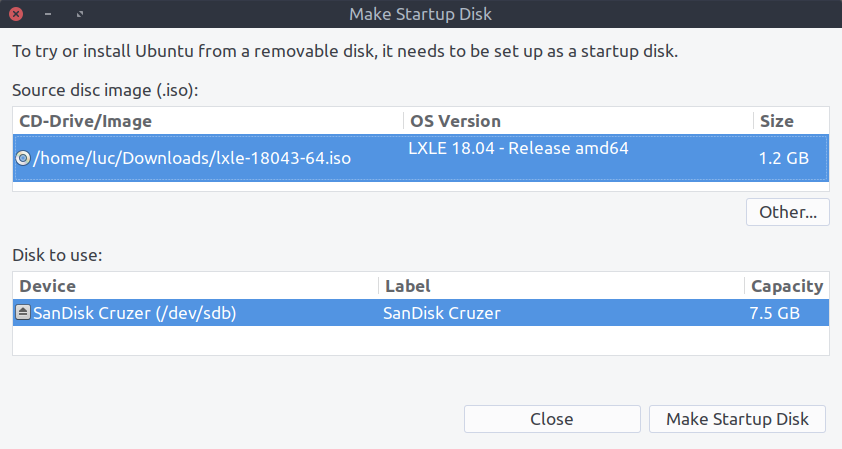Thursday, November 28, 2019¶
Running Linux on an older PC¶
Ticket #3357 is not directly related to Lino. I am installing LXLE on Ly’s old notebook computer in order to make it quick again so that Iiris can use it. It had become unbearably slow because it has only 2 GB of RAM, and Ubuntu is simply too fat for this old machine. Quote from a discussion on linux.org : “IMO to have an enjoyable 1st experience using Ubuntu 18.04 LTS or any Linux I would highly recommend at least 4.0 GB of memory. From my experience trying to run Ubuntu 18.04 LTS with only 2.0 GB memory will be painful at best.”
LXLE is a “Full featured OS for an aging PC” based on Lubuntu. I chose it after reading 10 Best Lightweight Linux Distributions For Older Computers.
I downloaded an ISO image from https://sourceforge.net/projects/lxle/
How to get the ISO file to an USB stick? This article suggests that that Startup Disk Creator can do it. I had to install python3-coverage before getting it installed:
$ sudo apt-get install python3-coverage
$ sudo apt install usb-creator-gtk

Before it actually starts writing, it asks “Are you sure you want to write to the selected device? All data will be lost.” The operation then takes a few minutes. At the end it says “Installation is complete. You may now run Ubuntu on other computers by booting them with this drive inserted.”
I manually unmounted the USB stick before removing it.
Another article suggests to simply use dd:
https://vitux.com/how-to-create-a-bootable-usb-stick-from-the-ubuntu-terminal/
Lino gets ready for Django 3.0¶
It’s already 10 days ago that they released Django 3.0 release candidate 1.
Now I did pip install --pre -U django and ran the test suite. I opened
#3360 for this.
“TypeError: not all arguments converted during string formatting” in
linowhen parsing the Django version. Now Lino will work also with Django 4+.ImportError: cannot import name ‘python_2_unicode_compatible’ : so I removed this decorator from everywhere (several hundred occurrences in more than a dozen repositories!)
Replaced “from django.utils import six” by “import six”. Started replacing
six.text_type()bystr()Soon we might also remove all usage of six, but that’s not a blocker.TypeError: ‘NoneType’ object is not iterable : seems that
Field.choicescan now be None. Okay, why not.TypeError: from_db_value() missing 1 required positional argument: ‘context’ :
That was because we have several Lino fields that define a
from_db_value()method:def from_db_value(self, value, expression, connection, context):
And the Release notes say clearly that “Support for the context argument of Field.from_db_value() and Expression.convert_value() is removed.”
So I changed the signature of these methods so that they support both Django 2 and 3:
def from_db_value(self, value, expression, connection, context=None):
django.core.exceptions.ValidationError: {‘choicelist’: [“Value ‘properties.HowWell’ is not a valid choice.”]}
The
lino_xl.lib.propertiesplugin is rather deprecated but still used in Lino Welfare.I moved the choicelists into a separate
choicelists.pymodule because I had a feeling that maybe that triggers the problem. Nope. But I leave them in a separate module.So what then is happening there? Aha, look at the PropType.choicelist field. It is defined as follows:
choicelist = models.CharField( max_length=50, blank=True, verbose_name=_("Choices List"), choices=choicelist_choices())
The
lino.core.kernel.choicelist_choices()function returns a sorted list of all choicelists in this application. But: this list is not yet populated when the modules.py modules are being imported. So the return value is always empty. Also in Django 2 this field does not have any choices. Django 3 detected a bug in our code that had gone unnoticed in Django 2 :-)The solution is to use a chooser, i.e. a choicelist_choices method. Now it works at least in Django 2.
All primary keys had sums in doctests. Lino assumes that the sum of a primary key makes no sense and therefore it is automatically hidden. This logic lives in the
lino.core.elems.AutoFieldElementclass where we say:class AutoFieldElement(NumberFieldElement): def value2num(self, v): return 0
The
lino.core.elems.field2elem()works by looping over a list of Django database field classes and finds the first element class found for the database field. One thing that’s new in Django 3 : AutoField now inherits from IntegerField. That makes sense, but it caused Lino to return an IntegerFieldelement for AutoField as well. The solution was easy: simply test for AutoField before testing for IntegerField.
Commits:
2019-11-28 20:25 in atelier: e6fadf7 (Merge branch ‘master’ of git+ssh://github.com/lino-framework/atelier)
2019-11-28 20:25 in atelier: afa38ad (http://luc.lino-framework.org/blog/2019/1128.html)
2019-11-28 20:25 in lino: e60f982 (http://luc.lino-framework.org/blog/2019/1128.html)
2019-11-28 20:26 in xl: 43aa3e6 (http://luc.lino-framework.org/blog/2019/1128.html)
2019-11-28 20:26 in noi: 1b5909d (http://luc.lino-framework.org/blog/2019/1128.html)
2019-11-28 20:26 in voga: a1a4504 (http://luc.lino-framework.org/blog/2019/1128.html)
2019-11-28 20:26 in care: c2f48e6 (http://luc.lino-framework.org/blog/2019/1128.html)
2019-11-28 20:26 in vilma: d95e68f (http://luc.lino-framework.org/blog/2019/1128.html)
2019-11-28 20:27 in avanti: 22f0f94 (http://luc.lino-framework.org/blog/2019/1128.html)
2019-11-28 20:27 in tera: 70f23b4 (http://luc.lino-framework.org/blog/2019/1128.html)
2019-11-28 20:27 in book: e9c3345 (http://luc.lino-framework.org/blog/2019/1128.html)
2019-11-28 20:27 in welfare: 08a558f (http://luc.lino-framework.org/blog/2019/1128.html)
2019-11-28 20:27 in welcht: 53a6168 (http://luc.lino-framework.org/blog/2019/1128.html)
2019-11-28 20:27 in presto: c371f6d (http://luc.lino-framework.org/blog/2019/1128.html)
2019-11-28 20:28 in amici: 3726f2e (http://luc.lino-framework.org/blog/2019/1128.html)
2019-11-28 20:28 in ciao: 7720961 (http://luc.lino-framework.org/blog/2019/1128.html)
2019-11-28 20:28 in algus: 3f07497 (http://luc.lino-framework.org/blog/2019/1128.html)
2019-11-28 20:28 in blog: 8665f8b (http://luc.lino-framework.org/blog/2019/1128.html)
2019-11-28 21:44 in lino: 7326925 (http://luc.lino-framework.org/blog/2019/1128.html)
2019-11-29 04:28 in lino: 28480c6 (keep ContentType.__str__() as it was in Django 2)
2019-11-29 04:40 in blog: e718675 (http://luc.lino-framework.org/blog/2019/1129.html)